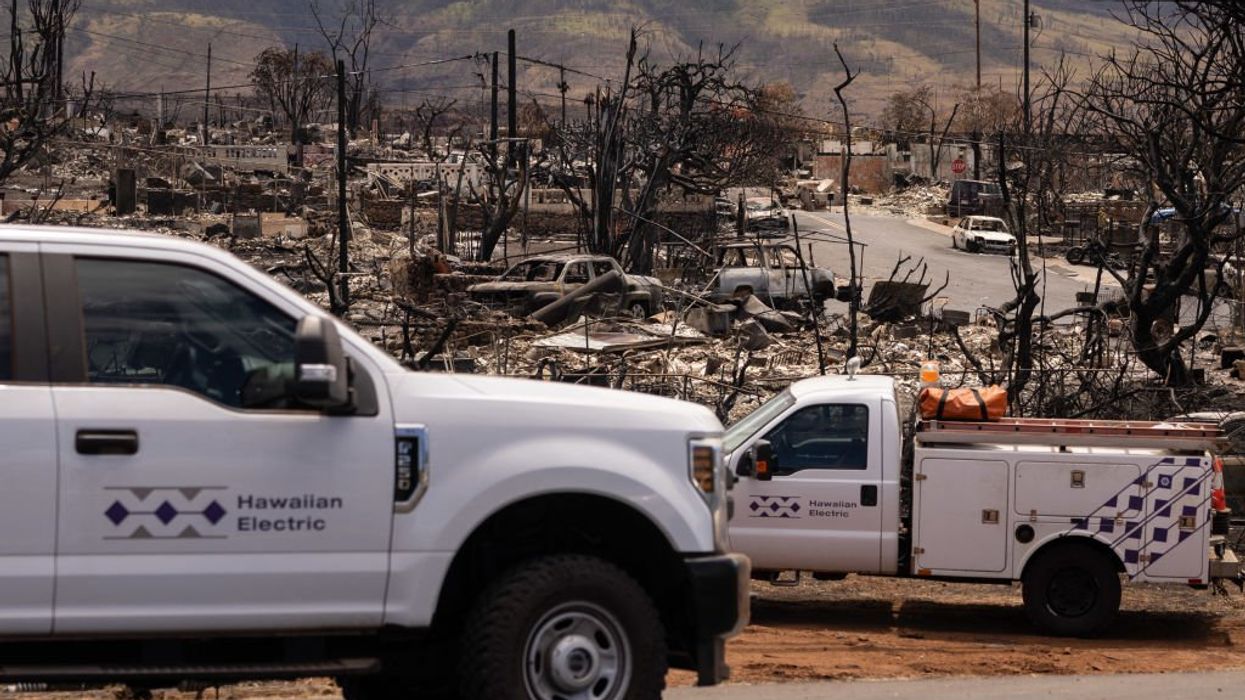
Photo by YUKI IWAMURA/AFP via Getty Images

A number of Democrats and other leftists have blamed the deadly wildfires in Hawaii on the specter of anthropogenic climate change. They may be right, but only in a perverted sense.
Like the Biden administration, Hawaii's Gov. Josh Green (D) and both the state's 88%-Democratic House and 92%-Democratic state Senate are ostensibly keen to "lead the globe on clean energy and climate issues."
It appears that the efforts by Hawaii's largest energy provider to follow suit and satisfy a Democrat-mandated transition to renewable energy took priority over alternatively pragmatic efforts to maintain its equipment and deal with the known and documented threat of fuel buildup in the form of flammable vegetation.
Hawaiian Electric, which serves 95% of the state's 1.4 million residents, was slapped with a lawsuit Wednesday, which alleged the "negligent and reckless operation" of its infrastructure "necessarily cause the Lahaina fire," reported Forbes.
The utility company, which also owns one of Hawaii's biggest banks, issued a statement on Aug. 8, noting there were scores of downed electric poles in various parts of Maui and warning Hawaiians to assume they were energized.
The New York Times indicated that Hawaiian Electric had not preemptively shut down the lines ahead of high wind warnings, with the company's chief executive Shelee Kimura admitting as much in recent days.
The negligence lawsuit claimed that extra to Hawaiian Electric providing an "ignition source" — having allegedly failed to "deenergize power lines during a High Wind Watch or Red Flag Warning, and ... shut off the power during those conditions" — the company had also neglected to adequately clear flammable vegetation and maintain its equipment.
Mikal Watts, a lead attorney on the case, told NBC Wednesday, "Hawaiian Electric is not just responsible and they weren’t just negligent. ... They were grossly negligent by making conscious decisions to delay grid modernization projects that would have prevented this very tragedy."
In the aftermath of the ruinous blazes, at least three other lawsuits have reportedly been filed that advance similar allegations.
The Wall Street Journal reported that Hawaiian Electric has known about the pressing need to take preventive measures concerning wildfire threats for years, concluding during the 2019 wildfire season that it needed to ensure its power lines would not spit sparks.
This preventive measure would have been especially important, not because of so-called climate change, but because flammable, invasive plants have overgrown derelict farms and taken over one-quarter of state land, leaving Hawaii crowded with potential fuel.
Despite recognizing the need to act, the Journal indicated that Hawaiian Electric spent less than $245,000 on wildfire-specific projects on Maui between 2019 and 2022, according to regulatory filings. It didn't press the state for approval to raise rates to pay for such improvements until June 2022 and still has yet to receive it.
While Hawaiian Electric has made various commitments to take precautionary measures to "minimize the risk of sparks when winds picked up," the Journal reported that former regulators and energy company officials said the utility was preoccupied "at that time procuring renewable energy."
This focus was largely resultant of the state's 2015 mandate to totally transition to renewable energy.
According to the Democrat-authored 2015 law, Hawaii is required to meet interim renewable portfolio standards of 40% by 2030, 70% by 2040, and 100% by 2045.
Mina Morita, former chair of Hawaii's utility commission, told the Journal, "You have to look at the scope and scale of the transformation within [Hawaiian Electric] that was occurring throughout the system. ... While there was concern for wildfire risk, politically the focus was on electricity generation."
In addition to allegedly prioritizing the green transition sought by Democrats over wildfire prevention measures, the utility also reportedly put off investing in mitigation until its coffers could be filled.
While Hawaiian Electric reportedly talked about spending roughly $190 million on power line maintenance and repair, removing flammable vegetative material, and taking other measures to mitigate wildfire risks, the Journal indicated that the company declined to "start on the work until it ha[d] state approval to recoup costs from customers — a common occurrence when utilities seek to make large investments."
Bloomberg reported that power lines have sparked numerous deadly fires across the United States in recent years. In California, the state's largest utility, PG&E Corp., went bankrupt in 2019 after its equipment was deemed responsible for blazes, including the 2018 Camp Fire, which claimed the lives of 85 people.
As of Thursday morning, authorities had confirmed at least 111 people have died in the Hawaii wildfires.
The Journal indicated the utility had not yet responded with comment.
Like Blaze News? Bypass the censors, sign up for our newsletters, and get stories like this direct to your inbox. Sign up here!